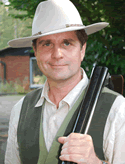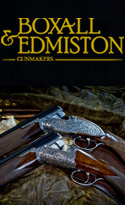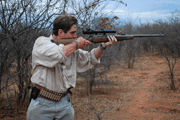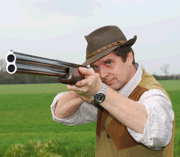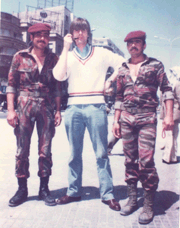Gun Fit Part I
There are few things in life which are quite as satisfying to possess as a really well fitted shotgun. Just what is a well fitted gun? The glib answer is that you will know one when you try it (and if you ever have one and get rid of it you will regret it!). A well fitted gun is one that feels right, that points naturally to where the eye or eyes are looking and that controls recoil effectively. Such a gun will make anyone shoot better, even the man capable of shooting a reasonable round of skeet from the hip. A well fitted gun is more forgiving and comfortable to use. Even when we make slight mounting errors it will still kill the target. It is often said that the man behind the gun is more important than his weapon. True, but put a good shot together with a perfectly fitted gun and the combination becomes really hard to beat. I know of no shotgunners who think that they can do their best with any ol' gun. Our goal in the shotgun sports is 100% not 99.
Lets get down to the nitty gritty. Essentially there are four variables of gunfit: drop (sometimes called bend), length, cast, and pitch and grip (by which I mean the size, shape and angle of the grip). Balance, trigger pulls, gun weight, barrel length and weight, relative point of impact and rib height and elevation are also important issues and should be considered along with stock fit. In this first part, however, we will consider only drop and length. That will be quite enough to think about! We'll begin with drop, which is, in my opinion, the most important of all the gunfit variables.
Drop
Once the rib is set in position, drop controls the elevation of the gun in much the same manner as the backsight of a rifle. It is difficult to make consistent allowance for unsuitable drop dimensions (whereas small variations in length or cast do not make that much difference unless one is looking for excuses). Too high a stock may make you shoot high. Too low a stock can cause low shooting, but it can also cause inconsistent high-low shooting because of head lifting in compensation for the poor fit. Another problem with a low stock is that it can encourage the wrong eye to take-over (because the view to the master eye is blocked by the breech when the head is held on the stock). All things considered, a little too high is far better than a little too low.
What most people want for sporting clays or skeet is a drop dimension which will result in about 55-60% of the pattern being placed high and 45-40% low of the point of aim when the head is normally positioned on the stock. Some prefer truly flat shooting guns, but I caution against them as they can reduce target visibility. For trap shooting (or hunting) a higher shooting gun may be required. I have found that a fairly flat shooting gun (about 60:40) suits me well for normal trap shooting, however, my scores at wobble trap improve when I add about 1/8” extra to comb height. I am no fan of extremes, a 70:30 pattern distribution relative to point of aim is as high as I would ever want to go on any trap gun (yet, I acknowledge that there are some excellent shots who use guns which throw almost the entire patterns above the mark).
Having got into some numbers, I might now mention that drop is usually measured "at comb" and "at heel". Sometimes, a more central "drop at face" measurement may also be taken. Drop is simply the distance between the top of the stock comb and the axis of the top surface of the rib (or the front and rear points of the rib in the case of concave or shallow ribbed side by sides) as measured at the front and rear of the comb [see diagram]. Typical dimensions for a modern, factory made, over an under intended for sporting clays would be about 1 3/8" at comb and 2 1/8" at heel (assuming a conventional rather than Monte Carlo stock). Old guns may be lower (19th century guns often had 3” or more of drop at heel, before WWII 2 ½” was a common dimension). English guns, interestingly, have tended to have higher combs (and longer stocks with more cast) than those made in the USA. The classic dimensions for an English side by side would be about 1 1/2" and 2" (although there is tremendous variation because nearly all these guns are custom made).
Here is my simple advice for sporting shooting, conventional ATA trap or NSSA skeet (consider it only as a starting point for experiment). Set the stock up so that the bulk of the iris, the coloured part of the eye, appears to be sitting centrally on the breech when your head is in a normal, unstrained, position on the stock. The pupil should appear to sit on the breech/rib, like this:
I have assumed that you are using an over and under or repeater and that you do not need a great deal of cast (and if that term baffles you see next month's issue). There are some other qualifications too. It has been my experience that side by sides tend to shoot a little lower than over and unders - all other things being equal. It has been suggested that this low shooting is because the barrels and grip are more flexible than those on over and unders and therefore subject to more downward flex in recoil. This may be so, whatever the answer, if you use a side by side, I advise a slightly higher fit than for a stack barrelled or single tubed pump or auto. Similarly, long barrelled guns (32-34") can have a practical tendency to shoot low too and may want a slightly higher comb in compensation for this [short, stiff barrelled, guns by contrast may have a tendency to shoot high as do some very light, small gauge, guns].
I have also found a higher fit to be useful in an Olympic Skeet gun. This discipline has a very rapid mount from an extreme gun-down position than can lead to chopping below the line of the bird, a high fit can compensate for this. Similarly with a hunting gun. The high fit has the added advantage in this case that it helps one to keep up on the line of rising birds and equates to a little more lead on many targets. In particular, a high fit may be especially useful for the 'one eyed' hunter (i.e the man or woman who closes an eye), because visibility is generally increased and because the built in lead of a high comb will facilitate shots at rising or incoming birds.
Thus, as a starting point for side by sides, long guns, trap guns to be used for fast bird disciplines, Olympic skeet guns and any gun to be used for hunting, I suggest the following as a place to begin. Note now that almost the entire iris is seen to ‘sit’ on the breech:
As well as effecting the position of the eye in the vertical plane, drop also affects the positioning of the butt sole at the shoulder. Generally speaking (and there are exceptions), the top line of the stock of the mounted gun should be more or less in line with the top of the shoulder (the exceptions occur because some people like to mount the gun stock lower on the chest). One certainly does not want to see any significant amount of the butt sole projecting above the shoulder line. If it does, do not automatically assume it is a fit problem - it could be caused by a poor mounting style. Some people, for example, are in the horrible habit of bringing the gun to the shoulder and then bringing the head down to the stock. The gun should always be brought to the face first. Never adjust a gun to compensate for such faults in basic technique.
Those with long necks, sloping shoulders or small heads - may be well served with a monte-carlo stock. This can also be useful for young shots and women; anyone with a head smaller than the average male is likely to need a higher stock than the norm to get their eye properly in line with the rib. Monte-carlo stocks keep the top of the comb parallel or more-or-less parallel with the axis of the rib. In any stock, if there is a lot of slope in the comb felt recoil will be increased (especially if the slope of the comb is at odds with the shape of the user's face). If the comb is parallel or nearly parallel to the rib axis (and if the comb itself is well shaped), the comb will glide back under the cheekbone as the gun is fired and felt recoil will be reduced. This brings us to RULE 3: keep the difference in the dimensions at comb and heel as small as possible.
Length
The length of the gunstock (also called the 'length of pull') is the distance from the middle of the trigger to the middle of the butt sole. Professionals will also measure the length to heel and toe (which determines pitch (which we will consider in more detail next week). Sticking to the KISS philosophy, we might note: use as long a stock as you can comfortably mount and swing. This is most usefully determined in the case of sporting shooting by a high overhead shot (a tower bird or something similar). Too short a stock will increase the recoil you feel; too long a stock will check the swing. Most experienced sporting shots tend to prefer a longer stock in my experience. Once one has perfected the mechanics of the mount, a longer stock allows for more control. A typical length measurement as required by an adult male would be in the range 14 to 16". Most factory guns are made with dimensions between 14 1/4 and 14 3/4". One size certainly does not fit all.
You automatically assume that all your guns should have the same length of stock. For ease of mounting, very heavy guns should be shorter and very light ones (such as small bores) longer all other things being equal. A hunting gun for use in the winter with heavy clothing, moreover, will want to be shorter than a competition gun to be used in spring and summer. As a rough guide for 12 bores of normal weight, I like to see about two finger widths of gap between the base of the thumb and the tip of the nose when the gun is properly mounted. The popular method of holding the gun at the grip and seeing if the butt sole makes contact with the lower bicep when the arm and gun are held up is imprecise and should be used with caution as a only very rough guide (it can give you a rough idea when sizing up a beginner who has little idea how to mount a gun).
Whether considering length or drop (or, for that matter, any other gunfit variable), never start with any 'ideal' measurements in mind, what is right is what suits the individual as assessed by trial and observation in the chosen discipline. My practical advice is to begin by gettting length approximately correct, then work on drop, before fine tuning the length. Do not be afraid to make temporary adjustments by means of comb raisers or strips of card taped to the stock with vinyl electrician's tape (which will not have any serious effect on wood finish if carefully used). If you use a butt extender in your experiments, cardboard shims may be cut to increase length and wrapping the boot with tape will prevent snagging. Find a rubber one if you can, the leather type tend to be too bulky and usually have a very poor sole shape. If your problem is too high or too long a stock, enlist the help of a gunsmith and proceed with caution and patience. Wood is easily removed, but hard to replace.
STOCK ALTERATIONS
Alterations for drop (and cast) are usually made by placing the stock in a jig, heating the grip area by means of hot oil, steam or infrared light (my favourite) and applying pressure in the desired direction. The stock must be pushed a little further than required as there is a tendency for the wood to spring back when it is cooled. Drop and cast may also be altered 'at the head' by removing small amounts of wood from the stock in the area where it meets the back of the action. Drop can also be reduced by removing wood from the top of the comb (though this is best left to an expert if the shape of the comb is to be properly preserved) or increased, by inletting wood. I frequently raise combs in this way, adding the comb section of an old, broken, stock to a flat machined onto the top of the stock of the gun being modified. The usual result is a subtle monte-carlo comb.
A comb which is a little too high is far better than one which is a little too low
Do not adjust guns to faults in basic technique
Keep the difference between drop at comb and heel to a minimum
Use as long a stock as you can comfortably mount and swing
Never start with any ideal dimensions in mind
Do not be afraid to experiment with temporary adjustments


